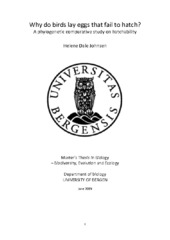Why do birds lay eggs that fail to hatch?
Master thesis
Permanent lenke
https://hdl.handle.net/1956/20349Utgivelsesdato
2019-06-22Metadata
Vis full innførselSamlinger
- Master theses [267]
Sammendrag
In birds, an average of 10-15% of eggs reportedly fail to hatch and remain in the nest after completed incubation. This is due to either fertilization failure or embryo death. Hatchability (the proportion of eggs hatching) is known to vary considerably between different bird species, but the explanation for the high average proportion of hatching failure remains unclear. In this study I replicated a previous comparative study on hatchability (Koenig 1982) but in contrast to that study controlled for possible phylogenetic effects. I show that hatchability increases with relative clutch mass (residuals of regression between egg mass and incubator body mass) and absolute latitude, and that open nests show a higher hatchability than closed nests. None of these findings support the prediction that exposure of the eggs to cold temperatures would lead to higher levels of hatching failure. The positive correlation between hatchability and absolute latitude is also negatively affected by the duration of incubation periods. Birds with herbivorous/granivorous diets was found to have significantly lower hatchability than omnivores and invertebrate-eaters, contrary to both my prediction and results of previous studies. Moreover, values of hatchability were generally not more similar between closely related species than between other species. My results demonstrate that hatchability is a complex phenomenon affected by multiple variables. However, the exact mechanisms underlying the observed variation in hatchability are often not clear and need more detailed studies in the future.
